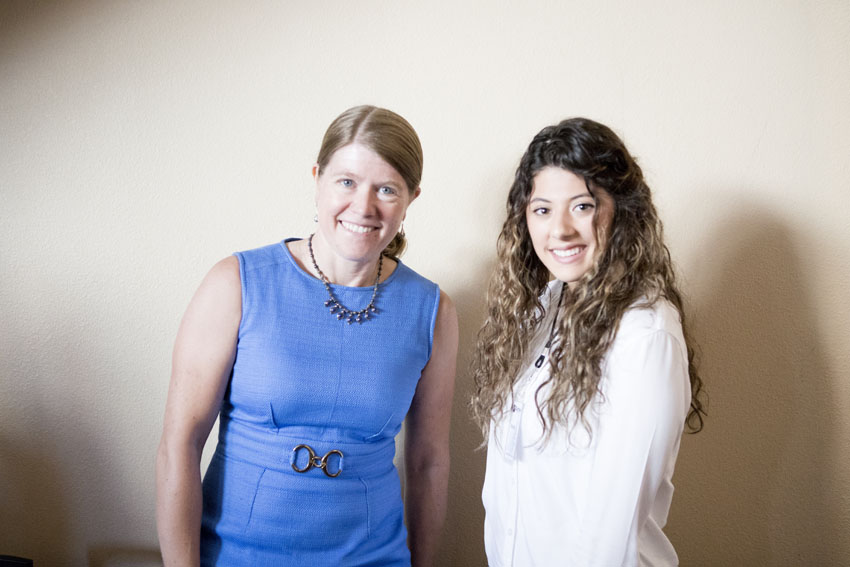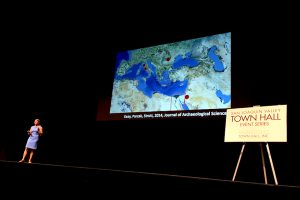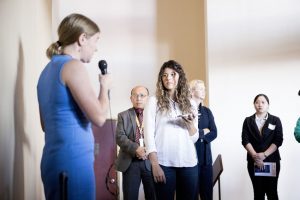
Dr. Sarah Parcak shares at SJV Town Hall
$1M TED prize recipient and well known space archaeologist Dr. Sarah Parcak, spoke at San Joaquin Valley Town Hall, Oct. 17. Dr. Parcak directed her topic of discussion towards new technology for assisting discovery of lost history in Peru and Egypt.
Dr. Parcak explained these two historically rich sites and their alignment with the use of satellite imaging. Sharing her website GlobalXplorer, Parcak hopes others will join her efforts in discovering hidden history. Parcak’s bachelor’s degree in Egyptology and Archaeological studies from Yale University and her Ph.D from the University of Cambridge allowed for discoveries to go beyond her home. She has taught anthropology, Egyptian art, and history at the university level. Parcak’s main focus to study is the Middle Earth Egyptian area.

Throughout her childhood, Dr. Parcak held a passion for Egypt which drove her to become the accomplished archeologist she is today. Parcak provides advice for any student interested in becoming an archeologist.
“I tell any students wanting to become an archeologist to study archeology but also double major in a science,” Parcak said. “There is so much amazing work being done today with DNA like understanding ancient populations, learning about disease, using chemical analysis on pots to learn about their food tendencies. Technology has upgraded the efficiency of dating, mapping, surveying and crowdsourcing.”
Space archaeology uses a variety of satellite datasets from commercial satellite providers, NASA and imagery taken from aircrafts. They program the data into algorithms to analyze and tease out details, helping to discover previously unknown cities and archeology features.
First becoming popular in 1984, this technology is now used all over the world, in Asia, the Middle East, Central, South and North America. Dr. Parcak showcases a few of the ways this technology has spiked the ability to accrue hands on excavations.
“The nice thing about the use of the technological methods alongside the traditional methods is finally having the accuracy we always craved,” Parcak said. “Now when we go to excavate we know right where a temple is and tombs as well, unlike before when it was harder to know where to dig and required more guess work.”
If you empower people to be explorers and take part in helping to discover the past, especially kids, then they will grow up valuing the history. Maybe in the future people won’t loot sites as much. — Dr. Sarah Parcak, space archaeologist
Dr. Parcak and her husband Dr. Greg Mumford have spent time utilizing satellite imagery, discovering over a thousand unknown sites in need of excavation and exploration. After winning the 2016 TED talk millionaire dollar prize, she used it to fund GlobalXplorer, empowering the world to help make cultural discoveries.
“GlobalXplorer is a free online crowdsourcing platform that allows anyone in the world to help find ancient archaeological sites,” Parcak said. “We wanted to empower the world to help us make discoveries.”

However, even at the launch of her website, questions still remained. Questions like, “Would it work? Would the website crash? Would the public find anything new?” These still worried her and the whole idea became an experiment in inviting the crowd to help discover the past. Her team spent a long time designing and considering the wide audience they wanted to appeal to.
“Our hope is to interest everyone, from the young student to the tech savvy and even the elderly,” Dr. Parcak said. “We really became thoughtful of the user experience, and decided full transparency was essential. When going on the site you can see how many users have been on and how many tiles are explored each day. We also have amazing photography from national geographic photos to help celebrate the extraordinary diversity and culture in Peru as well as share information about Peru.”
One of the biggest problem across the archeological world is with satellites’ inability to see through trees. When Dr. Damian Evans began exploring in the jungle forest of Krong Siem Reap, Cambodia, he looked at the ancient civilization of Angkor Wat using a light detection and ranging system called liDAR. LiDAR uses a laser sensor system, flown above the trees in an aircraft and sends millions of pulse beams of light down to the treetops.
Hello Xplorers! We are excited to introduce the GlobalXplorer community to our Patreon page. We will be using this platform for both fundraising and as a blog for our #citizenarchaeologist community! We hope you consider joining today at https://t.co/Sjgof3P4O8
— GlobalXplorerº (@Global_Xplorer) July 24, 2018
Many liDAR beams break through the tops of trees and a considerable amount even hit the floor vegetation. With the collected lidar data you can use specialized computer programs to remove the overlaying levels of vegetation and are then left with a bare earth model.
“From bare earth models you analyze exactly what’s on the jungle floor and beneath,” Dr. Parcak said. “What Dr. Damian and his team did was scan hundreds and hundreds of square miles around Angkor Wat. From there they completed work nothing short of evolutionary, they could show not only know where the Angkor Wat temples were but also places where the people lived. He ultimately ended up helping rewrite the civilizations history.”
One of the biggest liDAR studies ever completed was held in the rainforest of Guatemala, covering two-thousand square miles. It discovered more than sixty-thousand new archeological features in and around Tikal.
<span data-mce-type=”bookmark” style=”display: inline-block; width: 0px; overflow: hidden; line-height: 0;” class=”mce_SELRES_start”></span><span data-mce-type=”bookmark” style=”display: inline-block; width: 0px; overflow: hidden; line-height: 0;” class=”mce_SELRES_start”></span>
Looting is a common issue and goes back thousands of years. At the time of the global recession, looting became an even bigger problem. During her time in Lisht, Parcak excavated and began reconstruction plans for the looted tomb of General Antifa. They went back months after the dig season with a computer system and recreated what they believe the tomb would have looked like.
“When you work at a site in especially in Egypt, it’s not just about finding cool things,” Dr. Parcak said. “Ultimately, we become the responsible care takers working with the Egyptian government of the site, so conservation is essential. You can’t just dig up something and leave it; so what we make sure to do with our team and a very talented Egyptian artisan was create thousands of mud bricks just the same way they did thousands of years ago. To preserve, reconstruct and eventually open up for tourism the newly excavated tomb.”

Educating young students and empowering them to go on and become successful archeologists is important to Dr. Parcak. As part of the dig season, she trained five young Egyptians from the Ministry of Antiquities.
Parcak spends a lot of time pondering how to protect sites from looters and preserving history. Partnering with local communities near sites, promoting the halt of purchasing antiquities and having a stable economy all positively improve site preservation. Parcak describes ways she believes we can change the world of looting and improve overall site protection.
“If you empower people to be explorers and take part in helping to discover the past, especially kids, then they will grow up valuing the history,” Dr. Parcak said. “Having participated in discovering things, maybe in the future people won’t loot sites as much.”
Through the use of GlobalXplorer, machine learning and cross-country partnerships, Parcak hopes to see the entire world mapped in the next 10 years. She feels this is a very achievable goal with the help of students and adults gaining interest in preserving the past. Using the online community and global excavations, Parcak strives to include the whole world in cultural discoveries.
Feather journalist, Annaleise Anderson, ’19, meets and interviews Dr. Parcak at a Town Hall meeting, Oct. 17, in the following Feather Instagram post.
Feather journalist, Annaliese Anderson, ‘19, interviews Dr. Sarah Parcak, Oct. 17. The San Joaquin Valley Town Hall kicks off its 82nd season and second lecture with Dr. Parcak, speaking on space archaeology with a focus on ancient Egyptian civilizations. Winner of the 2016 $1M @TED Prize, Parcak’s expressed goal is to find every archeological site on earth and preserve for future study. For more information on Dr. Parcak’s endeavors, stay tuned for journalist Annaliese Anderson’s article. #thefeather #fresnochristian @fresnotownhall #fresnotownhall #SJVtownhall #SarahParcak @cityoffresno @globalxplorer #spacearchaeology #citizenarchaeology #xploretheworld @natgeo #globalxplorer @fresnochristianschools pc?: @averymakenna.photography
Annaleise Anderson can be reached via email and via twitter.
For more articles, read Cyber security awareness month draws attention to growing issue and Kareem Abdul-Jabbar proves leadership on and off the court.